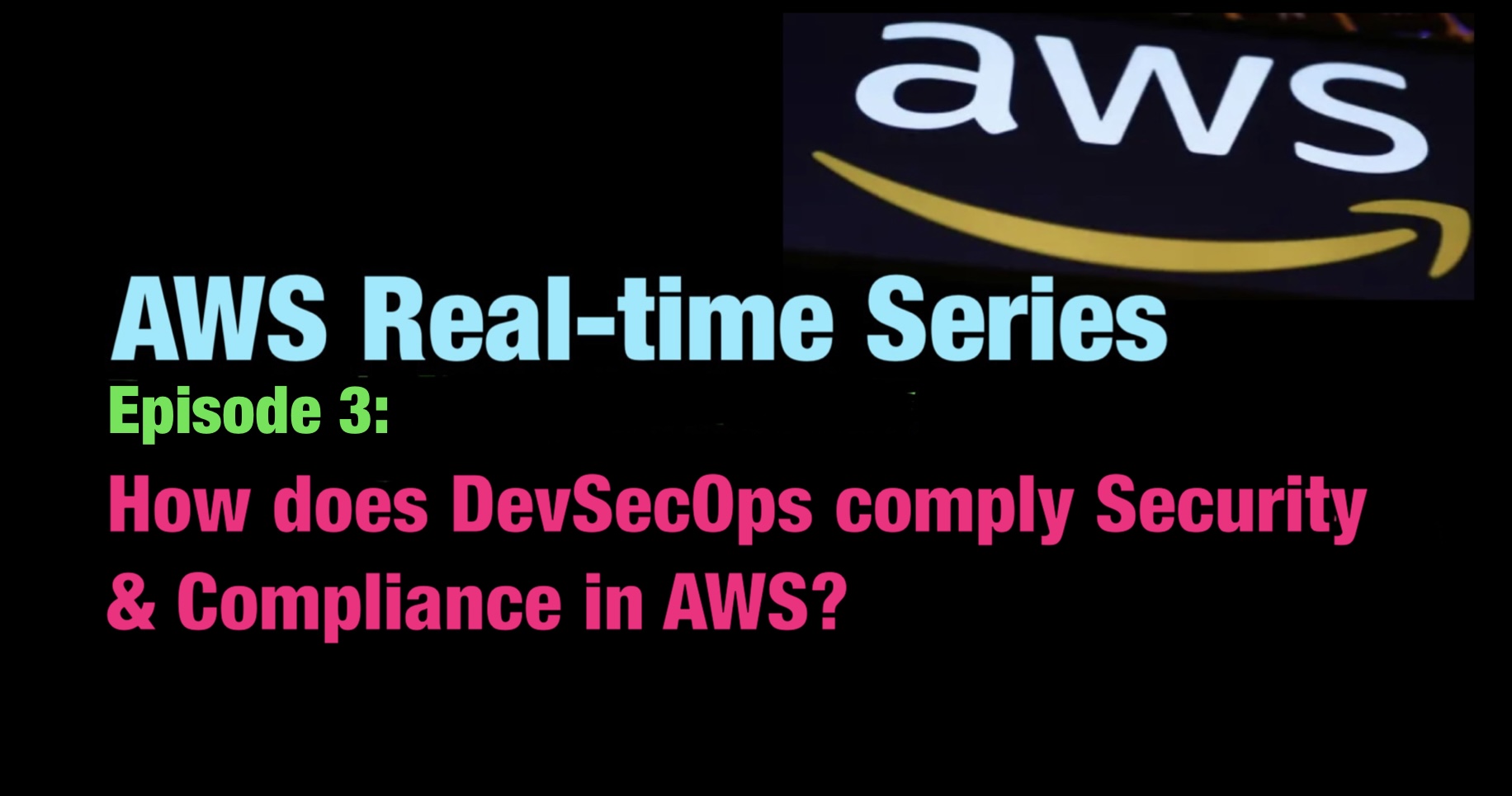How does DevSecOps comply with Security & Compliance in AWS?
 Azizul maqsud
Azizul maqsud
Security teams are facing another obstacle as more work-loads moved online and data breaches become commonplace. Earlier, query was only what is security? Now, what is the better security?
Better security, yes it is very much a good thing, but stricter protocols are very expensive at a time! These driving factors behind the DevOps team has brought automation to DevOps security; and, thus DevSecOps team is formed and removes the friction between DevOps and security teams enabling faster and safer development cycles in the project.
Q: As a DevSecOps engineer, how do you secure the architecture for AWS web services?
As a DevSecOps engineer, securing the architecture for AWS web services involves implementing a combination of best practices, tools, and processes. Here are some key steps you can take:
1. Least Privilege Principle: Apply the principle of least privilege by granting only the necessary permissions to users, roles, and services. Use AWS Identity and Access Management (IAM) to manage access and enforce strong password policies.
2. Infrastructure as Code (IaC): Utilize infrastructure as code tools like AWS CloudFormation or AWS CDK to define your infrastructure in a version-controlled and reproducible manner. This ensures consistency and reduces the risk of misconfigurations.
3. Secure Network Design: Follow secure network design principles using AWS Virtual Private Cloud (VPC). Isolate your resources using private subnets, implement network security groups, and use network access control lists (ACLs) to control traffic flow.
4. Encryption and Key Management: Implement encryption for sensitive data at rest and in transit. Utilize AWS Key Management Service (KMS) for managing encryption keys and AWS Certificate Manager (ACM) for SSL/TLS certificates.
5. Secure Development Practices: Embrace secure coding practices, perform regular code reviews, and utilize security testing tools. Employ techniques like input validation, output encoding, and parameterized queries to prevent common web vulnerabilities.
6. Security Monitoring and Logging: Enable AWS CloudTrail to log API activity and use AWS CloudWatch for monitoring and alerting. Implement centralized logging and analysis using services like Amazon CloudWatch Logs and AWS CloudTrail Insights.
7. Incident Response and Recovery: Define an incident response plan to handle security incidents promptly. Implement automated backups and disaster recovery strategies using AWS services like AWS Backup and AWS Disaster Recovery.
8. Regular Security Assessments: Conduct regular security assessments and penetration testing to identify vulnerabilities and address them proactively. Utilize AWS security services like Amazon Inspector and AWS Config for continuous security assessments.
N.B: It is important to remember that security is an ongoing process, and it’s important to stay updated with the latest security advisories, apply patches promptly, and monitor AWS security announcements for any potential vulnerabilities or risks.
Q: What is the compliance framework for AWS Web Services?
Security and Compliance works together in the role of DevSecOps! And, AWS provides a robust compliance framework to meet various industry-specific and regional compliance requirements. The compliance framework for AWS Web Services includes the following key components:
1. Shared Responsibility Model: AWS follows a shared responsibility model, where AWS is responsible for the security “of” the cloud, including the infrastructure and foundational services, while customers are responsible for security “in” the cloud, including the secure configuration and management of their applications and data.
2. Compliance Programs: AWS offers a comprehensive set of compliance programs, including certifications, attestations, and assurances, to demonstrate adherence to global security and privacy standards. These programs cover a wide range of compliance requirements, such as GDPR, HIPAA, PCI DSS, ISO 27001, SOC 1/2/3, FedRAMP, and many more.
3. AWS Artifact: AWS Artifact is a central repository that provides on-demand access to AWS compliance reports, including certifications, attestations, and third-party audit reports. It simplifies the process of obtaining compliance documentation required for audits and regulatory purposes.
4. Security Controls: AWS has implemented a wide array of security controls and features across its services and infrastructure. These include access management and identity controls, data encryption options, network security controls, logging and monitoring services, and secure development practices, among others.
5. AWS Config and AWS CloudTrail: AWS Config enables continuous monitoring and assessment of resource configurations, while AWS CloudTrail provides detailed logging and auditing of API activity and changes made to AWS resources. These services help maintain compliance by tracking and monitoring changes to the environment.
6. Compliance Automation: AWS provides various tools and services that aid in automating compliance tasks. This includes AWS CloudFormation for infrastructure as code, AWS Config Rules for defining and evaluating compliance rules, and AWS Systems Manager for managing patch compliance across instances.
7. Access Management and Auditing: AWS Identity and Access Management (IAM) allows fine-grained control over user access and permissions. It enables central management of user identities and supports multi-factor authentication (MFA) for enhanced security. AWS CloudTrail provides detailed logs of user activity and API calls, aiding in auditing and compliance monitoring.
8. Compliance Assistance Programs: AWS offers compliance assistance programs to help customers navigate and understand the compliance landscape. These programs provide resources, documentation, and guidance to assist customers in achieving and maintaining compliance with specific regulations.
N.B: It’s important to note that while AWS provides a secure and compliant infrastructure, customers are responsible for implementing their own security controls and practices to ensure compliance within their specific use cases and regulatory environments.
Q: As a DevSecOps engineer, how do you comply with the compliance framework for AWS Web Services?
As a DevSecOps engineer, ensuring compliance with the framework for AWS Web Services involves implementing specific practices and controls. Here’s how you can work towards compliance:
1. Understand Regulatory Requirements: Familiarize yourself with the relevant regulatory requirements that apply to your organization, such as GDPR, HIPAA, PCI DSS, or industry-specific standards. Gain a thorough understanding of the compliance controls and obligations outlined by these regulations.
2. Select Compliant Services: Choose AWS services that have undergone compliance assessments and are aligned with your specific regulatory requirements. Refer to AWS compliance documentation, including whitepapers and service-specific guidance, to ensure the services you use meet your compliance needs.
3. Secure Configuration: Implement secure configurations for your AWS resources by following best practices and guidelines provided by AWS. This includes using encryption for data at rest and in transit, configuring appropriate access controls, and enabling logging and monitoring features.
4. Identity and Access Management: Implement granular access controls using AWS Identity and Access Management (IAM). Follow the principle of least privilege, assigning permissions based on job roles and responsibilities. Utilize multi-factor authentication (MFA) to add an extra layer of security to user accounts.
5. Data Protection: Ensure compliance with data protection requirements by properly handling and protecting sensitive data. Utilize encryption mechanisms provided by AWS, such as AWS Key Management Service (KMS) for managing encryption keys, and AWS Certificate Manager (ACM) for SSL/TLS certificates.
6. Logging and Auditing: Enable AWS CloudTrail to capture and log API activity and changes made to AWS resources. Configure AWS Config to assess and monitor resource configurations for compliance. Implement centralized logging and analysis using services like Amazon CloudWatch Logs for security event monitoring.
7. Continuous Monitoring and Assessment: Regularly monitor your infrastructure and applications using AWS monitoring services like Amazon CloudWatch and AWS Config Rules. Set up alerts and notifications for any compliance-related issues or security events.
8. Automated Compliance Checks: Leverage automation tools like AWS CloudFormation or infrastructure-as-code frameworks to enforce compliance controls consistently. Define compliance rules as code using AWS Config Rules or third-party tools to automatically assess and validate resource configurations.
9. Regular Audits and Assessments: Conduct periodic audits and assessments to validate compliance with regulatory requirements. Use AWS Artifact to access compliance reports and relevant documentation required for audits. Collaborate with compliance and security teams to ensure adherence to compliance controls.
10. Regular Documentation: Maintain proper documentation of your compliance practices, security controls, and configuration settings. Document the processes followed, security measures implemented, and any deviations from standard practices.
N.B: Remember, compliance is an ongoing process, and it’s important to stay updated with regulatory changes, regularly review and update your controls, and perform regular audits to ensure continuous compliance with the framework and applicable regulations.
Compiled by: Azizul maqsud
References: https://aws.amazon.com/blogs/devops/enabling-devsecops-with-amazon-codecatalyst/
Subscribe to my newsletter
Read articles from Azizul maqsud directly inside your inbox. Subscribe to the newsletter, and don't miss out.
Written by

Azizul maqsud
Azizul maqsud
I am a DevOps Engineer